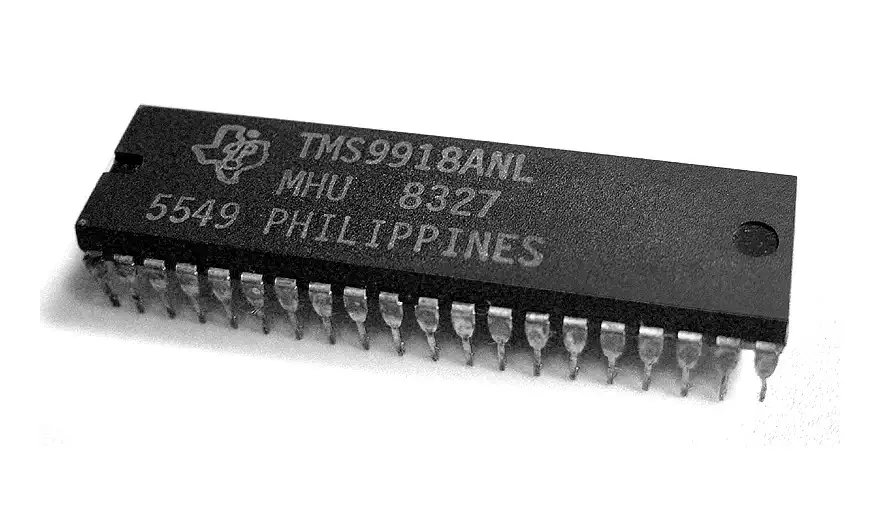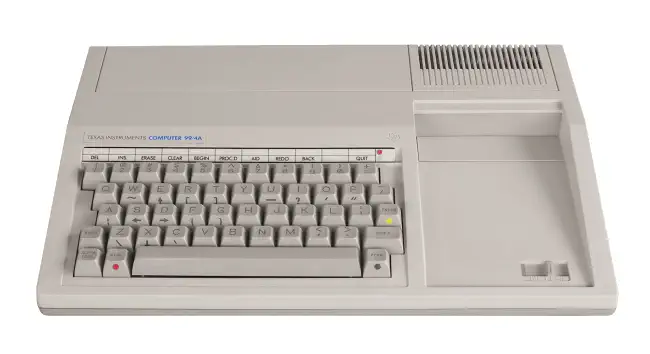Introduction
The TI-99/4A is basically the same system as the TI-99/4 but has a much improved keyboard. The price of the new model dropped by almost half, but still could not compete with the Commodore VIC-20 and Atari computers. By 1983 the 99/4A was selling under $100 and failed to make a profit. Eventually Texas Instruments decided to end production due to lack of sales and support.
Both TI-99/4 models use the 16-bit TMS9900 CPU running at 3 MHz. The TMS9900 is a single-chip implementation of a TI-990 minicomputer. Although a full 16-bit processor, only the system ROM and 256 bytes of scratchpad RAM are available on the 16-bit bus.
In order to build a complete 16-bit system, TI would have had to redesign many of their existing 8-bit support chips. Instead, TI decided to use existing devices for the majority of the system. The result was that only a small portion of the system was 16-bit, and used a second 8-bit computer bus for the rest.
One of the key features of the TMS9900 from the minicomputer design that spawned it was the inclusion of several sets of processor registers. Registers are used to store information that is being actively worked on by a particular program, as opposed to main memory which stores much more data but is slower to access. In a minicomputer setting, the system was typically running a time sharing or multitasking operating system, or being used for real-time computing, both of which benefit from being able to quickly switch among programs. To do this, the TMS9900 stored several sets of registers in main memory and could switch between the sets of sixteen 16-bit registers by changing the single workspace pointer register, thereby allowing very rapid context switching.
The new design put 256 bytes of random access memory (RAM) on the 16-bit bus to store up to eight sets of registers. This area of RAM is known as the "scratchpad memory". As the processor's instructions are all 16-bit as well, the 8 KB internal system read only memory (ROM) was also on the 16-bit side. Only the program counter, status register, and workspace pointer registers are actually implemented on the chip itself.Included on the 8-bit side of the system is the majority of the RAM and almost all of the support chips, especially the video display controller (VDP). All accesses to the VDP system are executed eight bits at a time. The system's RAM is managed by the VDP, which provides access to the CPU only when the CPU is not using the memory. This means that user programs and data has to be read over two machine cycles, essentially reducing speed by half. According to IEEE Spectrum, this negates the performance advantage of a 16-bit processor

TMS9918 Series Video Display Processor (99n8, 99n9, 91n8, 91n9)
The TMS9918 is a series of video display controllers (VDC) manufactured in 1979 by Texas Instruments, also refered to as 'Video Display Processor' (VDP). The TMS9918 and its variants were used in the ColecoVision, CreatiVision, Memotech MTX, MSX, NABU Personal Computer, SG-1000/SC-3000, Spectravideo SV-318, Spectravideo SV-328, Sord M5, Tatung Einstein, Texas Instruments TI-99/4, Casio PV-2000, Coleco Adam, Hanimex Pencil II, and Tomy Tutor.
Key Features:
- 256x192 pattern based color pixels per screen
- 16 different colors
- 8-bit memory mapped CPU interface
- No need for DMA, CPU can access VRAM
- 32 single color Sprites per screen (4 per scanline)
Variants:
- TMS9918A - 60Hz output, NTSC video
- TMS9928A - 60Hz output, YPbPr video
- TMS9929A - 50Hz output, YPbPr video
- TMS9118 - Different RAM than TMS9918A, otherwise identical
- TMS9128 - Different RAM than TMS9928A, otherwise identical
- TMS9129 - Different RAM than TMS9929A, otherwise identical

VRAM: 16kB Sound Chip TMS9919, later models used SN94624 Sound 3 voices, 1 white/periodic noise Display Chip TMS9919, later models used SN94624 Display 40x24 text
32x24 16 color text, pattern based
256x192 16 color, 2 color per 8 pix. Best Text 40x24 Best Color 16 colors (2 per 8 pixels) Best Graphics 256x192 in 16 colors Sprites 1 color, 16x16, 4/scanline, 32 total Original Price $525


